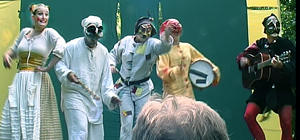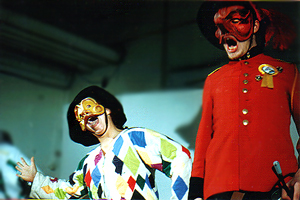In most theatre today there is an idea that the audience is supposed to sit down passively and don’t disturb the performance. We shut down the light in the house, demand total silence of the audience and then act like if there was a 4:th wall between the audience and the actors pretending there is another reality on stage. In the Royal theatre in Sweden it has gone so far that an actor in a Bergman directed play stopped the performance complaining that the audience where coughing. Read more HERE.
In Commedia dell’Arte the concept that the actors are trying to create their own reality upon the stage for the audience the watch, or rather peep at, does not exist. Everyone knows all the time that it is theatre and no one has to pretend that we are located somewhere else than at the theatre, city square, platform etc. There is no need for verfremdung in Commedia dell’Arte since one of the cornerstones in distance. We can talk about three levels of reality: the masks that wear masks, the masks that don’t wear masks and the audience.
To explain how it works I usually, when I lecture in Commedia dell’Arte, tell a little story about when I walked on a path in the forest, one of those covered with pine-needles that prickles ones feet. All around there is tall pines (I show with my hands) and it smells in that special way that one only can be found in a pine forest. –“You know that mixture of wood and grass, that smells when it is really hot?” (By now the audience usually nodes or shows that they know what I am talking about.) I was barefoot so I had to avoid all the pine cones everywhere. (Now I am up on my feet miming the whole thing) Here I abrupt the story. The illusion have been complete, everyone have been with me on that path in the forest. But I have never been trying to pretend that I have been somewhere else than where we are. I have told my audience about my walk and they have used their imagination to, using their inner eye, be there in the forest with me. They have probably also added some blueberry sprigs or heard birds singing.
Commedia dell’Arte is, in the same way, a narrative form of theatre. We tell the audience what we are doing all the time and we do the things we do in order to tell a story (or a situation), but we don’t always use words to do it. For example when Arlecchino does a back flip because someone gave him a punch on the nose (and everyone can see that it wasn’t even close to the mask) or when all the masks comes in with torches in their hands fumbling their way on stage just to tell the audience that it is dark, then the audience adds the fragments or the logic that is needed to create the believability in the story. In this way we are telling the audience what we are doing and we never try to make them believe that they are somewhere else or make them forget that they are watching a piece of theatre. Still they fill in the gaps and create the story with us. This also makes Commedia dell’Arte a very theatrical form of theatre.
Much of the comedy in Commedia dell’Arte is also based on that everyone, the masks, the actor, the audience knows that they are doing/watching theatre and play with that fact. It can be Dottore who keep putting on his glasses and every time notices the audience that he had forgotten or the cast that threatens to start all over again just because the audience are laughing too much and therefore are destroying the beautiful show they trying to play.


Pingback: Mask technique in Commedia dell’Arte in Commedia dell’Arte (Part 1) |
Pingback: Mask technique in Commedia dell’Arte in Commedia dell’Arte (Part 2) |
Pingback: Entrees, sorties and sidelines in Commedia dell’Arte |
Pingback: No 4:th wall in Commedia dell’Arte (Part 3) |
Pingback: No 4:th wall in Commedia dell’Arte (Part 2) |